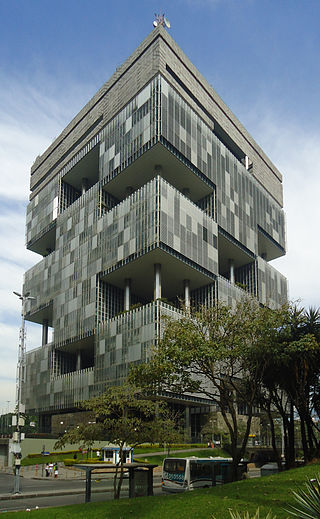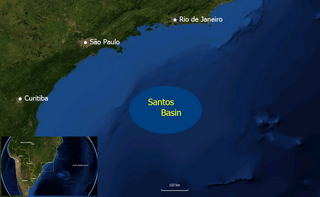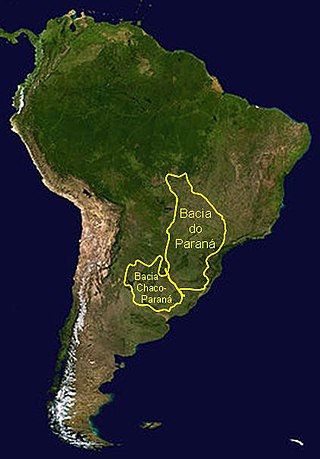The Campos Basin is one of 12 coastal sedimentary basins of Brazil. It spans both onshore and offshore parts of the South Atlantic with the onshore part located near Rio de Janeiro. The basin originated in Neocomian stage of the Cretaceous period 145–130 million years ago during the breakup of Gondwana. It has a total area of about 115,000 square kilometres (44,000 sq mi), with the onshore portion small at only 500 square kilometres (190 sq mi).

Petróleo Brasileiro S.A., better known by and trading as the portmanteau Petrobras, is a state-owned Brazilian multinational corporation in the petroleum industry headquartered in Rio de Janeiro, Brazil. The company's name translates to Brazilian Petroleum Corporation — Petrobras.

Brazil is the 7th largest energy consumer in the world and the largest in South America. At the same time, it is an important oil and gas producer in the region and the world's second largest ethanol fuel producer. The government agencies responsible for energy policy are the Ministry of Mines and Energy (MME), the National Council for Energy Policy (CNPE), the National Agency of Petroleum, Natural Gas and Biofuels (ANP) and the National Agency of Electricity (ANEEL). State-owned companies Petrobras and Eletrobras are the major players in Brazil's energy sector, as well as Latin America's.
Peregrino is an oil field located offshore of Brazil, east of Rio de Janeiro, in the southwest part of the Campos Basin area with about 2.3 billion barrels of oil in place within the sanctioned area. The oil field was discovered in 2004 and was formerly known as Chinook.
The Tupi oil field is a large oil field located in the Santos Basin, 250 kilometres (160 mi) off the coast of Rio de Janeiro, Brazil. The field was originally nicknamed in honor of the Tupi people and later named after the mollusc, however it was also ambiguously similar to the name of former Brazilian president Luiz Inacio Lula da Silva. It is considered to be the Western Hemisphere's largest oil discovery of the last 30 years.

The Santos Basin is an approximately 352,000 square kilometres (136,000 sq mi) large mostly offshore sedimentary basin. It is located in the south Atlantic Ocean, some 300 kilometres (190 mi) southeast of Santos, Brazil. The basin is one of the Brazilian basins to have resulted from the break-up of Gondwana since the Early Cretaceous, where a sequence of rift basins formed on both sides of the South Atlantic; the Pelotas, Santos, Campos and Espírito Santo Basins in Brazil, and the Namibia, Kwanza and Congo Basins in southwestern Africa.
The Lapa oil field is a deepwater oil field in the pre-salt Guaratiba Group of the South Atlantic Santos Basin, 270 kilometres (170 mi) off the coast of São Paulo, Brazil. The field lies in water depths of approximately 2,140 metres (7,020 ft). When the discovery of the field was initially reported, it caused widespread commotion because of the speculated size of the field, which surpassed the Mexican Cantarell Complex, the biggest oil field complex outside of the Middle East. The size of Lapa, then known as Carioca and later as Sugar Loaf, was announced as possibly "as large as 33 billion barrels [5.2 billion cubic metres]". Later appraisal of the field drastically reduced the reserves to the current estimate of 459 million barrels.

The Paraná Basin is a large cratonic sedimentary basin situated in the central-eastern part of South America. About 75% of its areal distribution occurs in Brazil, from Mato Grosso to Rio Grande do Sul states. The remainder area is distributed in eastern Paraguay, northeastern Argentina and northern Uruguay. The shape of the depression is roughly elliptical and covers an area of about 1,500,000 km2 (580,000 sq mi).

The coastline of Brazil measures 7,491 km, which makes it the 16th longest national coastline of the world. All the coast lies adjacent to the Atlantic Ocean.
Dommo Energia is a Brazilian publicly listed oil and gas company. Until 2017 it was known as OGX Petróleo e Gás Participações S.A. (OGX). Prior to a 2013 bankruptcy filing, OGX was Brazil's second-largest oil company by market value after Petrobras.

The FPSO Noble Seillean was a dynamically positioned floating oil production, storage and offloading vessel.
Iara oil field is a large ultra-deepwater pre-salt oil field located in the Santos Basin, 230 km (140 mi) off the coast of Rio de Janeiro, Brazil, north of Tupi oil field. It covers an area of nearly 300 km2 (120 sq mi).
Iracema is an oil field located in the Santos Basin, 250 km (160 mi) off the coast of Rio de Janeiro, Brazil, 33 km (21 mi) northwest of the giant Tupi oil field. Iracema is the third well drilled in the BM-S-11 block and could be an extension of ultra deep Tupi oil field. The field was previously called Cernambi.
Roncador oil field is a large oil and gas field located in the Campos Basin, 125 km (78 mi) off the coast of Brazil, northeast from Rio de Janeiro. It covers a 111 km2 (43 sq mi) area and reaches depths between 1,500 and 1,900 metres.
Búzios oil field is a large ultra-deepwater oil field located in the Santos Basin, about 230 km (140 mi) off the coast of Rio de Janeiro, Brazil. Originally named Franco oil field, it was the second largest pre-salt find in the basin since 2007, behind Tupi oil field, which holds between 5 and 8 billion barrels equivalent and is located just south of the Búzios oil field.

Libra oil field is a large ultra-deepwater oil prospect located in the Santos Basin, about 230 kilometres (140 mi) off the coast of Rio de Janeiro, Brazil, north of Tupi field. Libra is in the process of being tested and may turn out to be the largest pre-salt find in the basin, ahead of the Tupi oil field, making the largest find since Cantarell Field in 1976. National Agency of Petroleum (ANP) officials are confident Libra will contain even more recoverable oil than Franco oil field.
The Sapinhoá oil field is an oil field located in the southern Brazilian Santos Basin, 310 kilometres (190 mi) off the coast of Rio de Janeiro in a water depth of 7,065 feet (2,153 m). It was discovered in 2008 and originally named Guará field, under development by Petrobras. The oil field is operated by Petrobras and owned by Petrobras (45%) Repsol Sinopec Brazil (25%) and BG Group (30%). The total proven reserves of the Sapinhoá oil field range from 1,100–2,000 million barrels.
The Angola Basin is located along the West African South Atlantic Margin which extends from Cameroon to Angola. It is characterized as a passive margin that began spreading in the south and then continued upwards throughout the basin. This basin formed during the initial breakup of the supercontinent Pangaea during the early Cretaceous, creating the Atlantic Ocean and causing the formation of the Angola, Cape, and Argentine basins. It is often separated into two units: the Lower Congo Basin, which lies in the northern region and the Kwanza Basin which is in the southern part of the Angola margin. The Angola Basin is famous for its "Aptian Salt Basins," a thick layer of evaporites that has influenced topography of the basin since its deposition and acts as an important petroleum reservoir.

The Itajaí-Açu Formation is a geological formation of the Santos Basin offshore of the Brazilian states of Rio de Janeiro, São Paulo, Paraná and Santa Catarina. The predominantly shale with interbedded turbiditic sandstones formation dates to the Late Cretaceous period; Cenomanian-Maastrichtian epochs and has a maximum thickness of 2,000 metres (6,600 ft). The formation is a reservoir rock of the fields in the Santos Basin.

The Guaratiba Group is a geological group of the Santos Basin offshore of the Brazilian states of Rio de Janeiro, São Paulo, Paraná and Santa Catarina. The group forms the pre-salt layer in the petroleum-rich basin and hosts the biggest oil fields of Brazil, as Tupi, Júpiter and many more. The group contains, depending on the definition, three to four formations and dates to the Early Cretaceous period; Hauterivian to Early Aptian epochs. The total thickness of the group, representing the first phase of sedimentation after the break-up of Gondwana in the Santos Basin, is estimated at 4,200 metres (13,800 ft).









